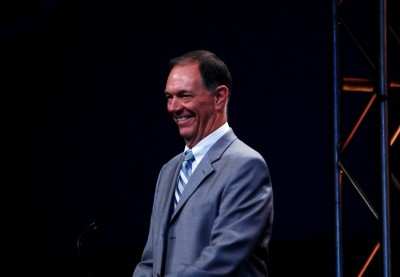Fri, Oct 21, 2011
New Facility Ready For NextGen
FAA Administrator Randy Babbitt was on hand Thursday for the
dedication of the new $72.6 million air traffic control tower and
radar approach control at Memphis International Airport. The new
tower enables air traffic controllers to continue to provide the
safest, most efficient service to both passenger and cargo
flights.

“This tower is a symbol of the FAA’s commitment to
aviation safety and modernization of the air traffic control
system,” said FAA Administrator Babbitt. “Our future
success depends on keeping our airport infrastructure healthy and
investing in NextGen so we can make air travel more efficient,
dependable and even safer.”
The new 336-foot-tall Memphis air traffic control tower is
equipped with state-of-the-art Next Generation Air Transportation
System, or NextGen, technology. The 850 square-foot tower cab has
enough room to accommodate additional future air traffic control
positions. The 24,000-square-foot base building houses training
rooms, administrative offices, and an expanded terminal radar
approach control (TRACON), with space for future growth. The new
facility has the latest seismic, security, and air traffic
simulation capabilities. Memphis Tower controllers handled 333,647
takeoffs and landings in 2010, making it the 22nd busiest tower in
the country. Memphis TRACON controllers handled 356,734 instrument
operations (overflights) in 2010, making it the 23rd busiest TRACON
nationwide.
The new facility has the latest radar, communications and
weather technology including:
- The Standard Terminal Automation Replacement System
(STARS), which provides air traffic controllers with
bigger radar displays on color monitors that are easier to read and
more detailed weather and flight information.
- ASDE-X: A ground radar safety system that
provides a high-resolution computerized display of aircraft and
vehicle movement on the airport surface. Memphis is one of 35
facilities to receive ASDE-X, which penetrates rain, fog and
darkness to give tower controllers a clear picture with which to
safely move aircraft around the airport. ASDE-X also updates
aircraft positions once every second.
- Integrated Terminal Weather System (ITWS): An automated weather
system that provides controllers near-term (0-30 minutes)
prediction capability of significant weather events including wind
shear, storm cell and lightning information.
- Collaborative Departure Queue Management
(CDQM): A key NextGen technology that shares real-time
data about the location of all aircraft and other vehicles on the
airport surface among controllers, pilots, airline operations
centers, airport operators and the FAA's Air Traffic Control System
Command Center. CDQM is being tested at Memphis Tower.
- Enhanced Traffic Management System (ETMS): The
system used by controllers to predict national and local traffic
surges, gaps, and volume based on current and anticipated airborne
aircraft. Controllers evaluate the projected flow of traffic into
airports and sectors, to determine and activate the best strategy
to ensure that traffic demand does not exceed system
capacity.
- Terminal Doppler Weather Radar (TDWR): A
sophisticated, high-resolution radar that detects all types of wind
shear in the airport terminal area. TDWR detects microbursts, gust
fronts, major wind shifts and precipitation intensity and displays
the information on a controller’s STARS displays. TDWR
enables air traffic controllers to provide pilots with specific
information on the location and strength of wind shear, with
sufficient advance warning to avoid it.
- Low-Level Windshear Alert System (LLWAS): the
system measures wind speed and direction at remote sensors located
around the airport. The remote sensor data is transmitted to a
master station, which generates warnings when windshear or
microburst conditions are detected.
More News
“Setting eight speed records this quickly following its August entry into service is a powerful testament to the tremendous capabilities of this aircraft. We are already seei>[...]
On-Course Indication An indication on an instrument, which provides the pilot a visual means of determining that the aircraft is located on the centerline of a given navigational t>[...]
Aero Linx: WW1 Aeroplanes, Inc. WORLD WAR 1 AEROPLANES was founded by Leo Opdycke in 1961 and incorporated as a federally recognized 501 (c) (3) not-for-profit corporation in 1979,>[...]
Pilot Reported That He Purchased The Airplane Earlier That Day Analysis: The pilot reported that he purchased the airplane earlier that day and completed a condition inspection tha>[...]
Also: Abu Dhabi’s 1st Vertiport Network, Anduril-EDGE Partner, Vertical Permit/eVTOL Regs Sierra Space’s Dream Chaser spaceplane has cleared another round of pre-flight>[...]
 Aero-News: Quote of the Day (11.18.25)
Aero-News: Quote of the Day (11.18.25) ANN's Daily Aero-Term (11.18.25): On-Course Indication
ANN's Daily Aero-Term (11.18.25): On-Course Indication ANN's Daily Aero-Linx (11.18.25)
ANN's Daily Aero-Linx (11.18.25) NTSB Final Report: Shoemaker Ronald R Pazmany PL-2
NTSB Final Report: Shoemaker Ronald R Pazmany PL-2 Airborne-NextGen 11.18.25: Dream Chaser Preps, Joby eTurbine, UAE Flt Test
Airborne-NextGen 11.18.25: Dream Chaser Preps, Joby eTurbine, UAE Flt Test



